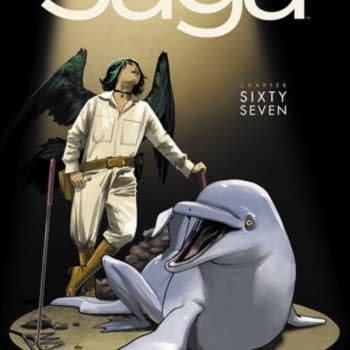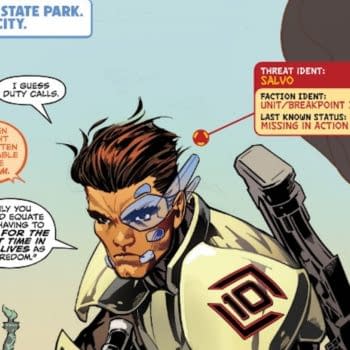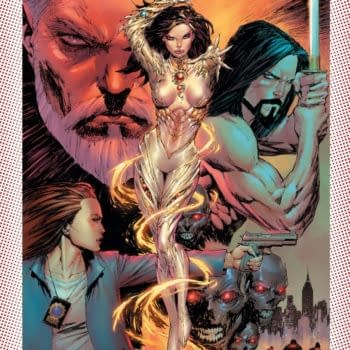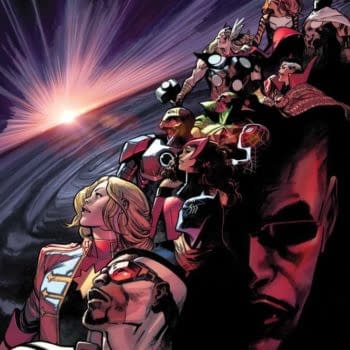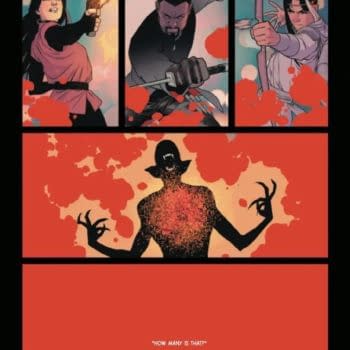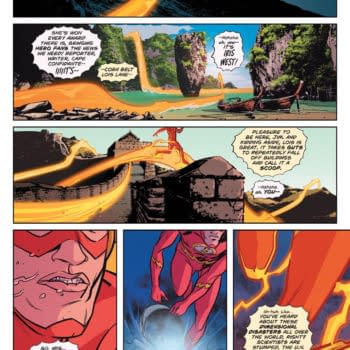Posted in: Comics, Recent Updates | Tagged: Comics, dc, relaunch, ron marz
REVIEW: Voodoo #1 by Ron Marz, Sami Basri and Jessica Kholinne

Later she would be written by Alan Moore, first taking her back to her dancing life, before exploring the spirtitual and magical impact she had naming herself Voodoo, creating a new identity for herself. Then she rejoined WildCATS. Then she returned to the pole again. She's never seemed to have been able to escape that lifestyle, even if she actually wanted to.
Now she's been reinvented, relaunched and rebooted for the DC New 52. And she's back on stage. But unlike, say, Action Comics, where you see Clark Kent as a journalist for a couple of pages, In Voodoo, you see her as a stripper for page after page after page, sixteen of the twenty pages feature her in her role, dancing on stage, performing a lap dances or changing clothes in the shared strippers dressing room.
And it's a bit much.
Let's be honest, pop culture doesn't exactly the best reputation for portraying the art of stripping in its narratives. One thinks of Striptease and Showgirls, it's only the likes of atypical performers that get any critical acclaim, such as Calendar Girls or The Full Monty. And Voodoo is definitely more the former than the latter, there is an abundance of flesh and it feels rather oppressive. If there is a cultural reference for this comic however, it's not so much Showgirls, but Species. Because hidden in this performer is a monster. This should be an easy leap in such a context, that that character never cares about showing her naked body, because her real naked body lies beneath this human flesh, but this doesn't even seem a conscious thought, more overanalysis on my part.
There is some critique of the stripping act however, in the way it makes the viewer a part of the process. The first time we see her, she is on her hands and knees, looking at the reader, surrounded by dollar bills, as if to ask "This is what you want? This is what you're paying for? Okay, let's do it, we both know why we're here." The presenter makes it even more explicit, narrating the performance for us, telling us "You know you want her, you know you love her, you know you can't take your eyes off her", a fixed visual position making us the as much the audience of the show as the audience of the comic book.
This seems to presuppose who the audience is, a straight male, into this thing. The reaction to Catwoman and Starfire is a rejection of that, with many voices coming from straight women and gay men who clearly object to that supposition. Well, they aren't going to find much joy here.
Much of the comic revels in what it gets to show. The stage dance, the lapdance, they feel extended and incredibly gratuitous, lingereing over stretched skin. Don't get me wrong, the storytelling here is spectacular, panels performing as beats to dance to, a clear narrative and definite sense of direction. It's just, I felt bored. The line work is equisite, with attributes in a Mucha-influenced style akin to Jamie McKelvie, Milo Manara or Adam Hughes, an awareness of the simplicity of the purposeful line, placed with precision, and used to portray weight and prescence on the page, a slightly heavier line used to outline the character's of note, with thinner lines to detail. And Basra does this with immense skill, his women have breasts that move and sag with direction and gravity, fat around the legs folds to convey prescence on the page, where other artsits would rely on shading, stipling or other extraneous lines, Basra needs none. And on these lines, Kholinne then layers in colour, easily flowing through the wide open spaces, twisting and turning, reflecting, taking on light and shadow. There is a problem here that in this process, a lot of the lines are dulled or dropped out and that seems to reduce the impact of the overall page. I urge you to find a black and white copy of this book just so that you can experience a different version, but the finished comic is still a very pretty thing. And there's some great use of shadow in the final scenes that imply a far more gruesome ending than that directly seen on the page. Again, think Species. But just as with much if Milo Manara's work, I'm enjoying the skill of the artwork – plot and character rarely enter into it. And even then, every panel seems an excuse for another glamour shot, straight from a photographer's stock poses and angles.
While the original Wildstorm character was initially unaware of her alien background until she was discovered, here she seems very aware, and we're given the possibility that she's part of a Bodysnatcher/Skrull-like alien invasion, integrating alongside us, learning secrets and, um, choosing the right skimpy underwear. The agents sent to deal with her also contrast her, the letch with his own secret and a woman who looks and dresses the opposite of the scenario she finds herself in, cropped hair, business suit and uncomfortable in the role she finds herself. And very deliberately given a scene in which she handles herself against a threat in a comparable, but very different way that Voodoo does. So whether you're a skeevy leering male, or a disapproving, uncomrtable woman, there's a point of view you can feel comfortable with. Opposites are set up, in some way to provide balance for the reader, but it also serves to exaggerate the position that Voodoo finds herself in.
This is a first issue, and some writers have been keen to express to me that this is all it is, that more will come, that aspects are being set up for future development. And all that is true. But for a first issue of a reboot with such a high profile, you need more than that, we need jam today not jam tomorrow. And while the ending may smack of jam all round, that's still a month away. Too much stripping, not enough reason to care about the stripper. It smacks too much of one of those late night cable TV movies, and it has the same self-justifying scenes that they do, before we get onto the removal of clothes. I did feel skeevy when reading it, but I'll probably find myself at least flipping through the second issue. Personal prejudices aside, I do have to recognise this as good looking comic book. I just get bored by what it's portraying so far. Should I hand my testicles in at the door?
Voodoo is not a beloved character from people's childhoods. And if this were a Top Cow book, or an Aspen book or, you know, French, there wouldn't be an outcry. But this is a reinvention in the relaunched DC Universe, with Catwoman and Starfire on many people's minds may transform it into something else.
Because, yes it's a T+ book. But really it needs an 'A' on the end of that.
Voodoo #1 is published tomorrow from DC Comics. We thank our anonymous donor for the advance copy.









